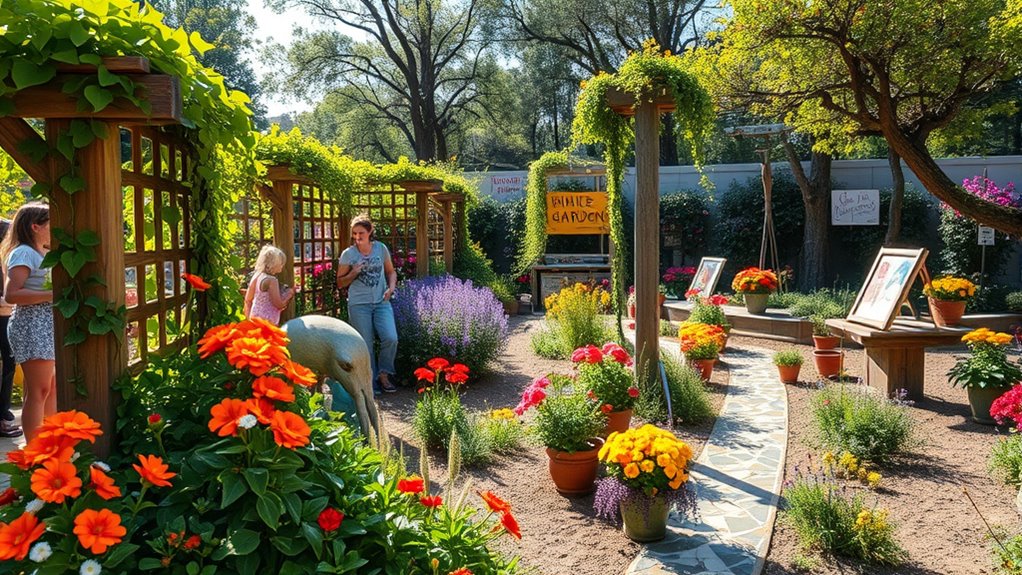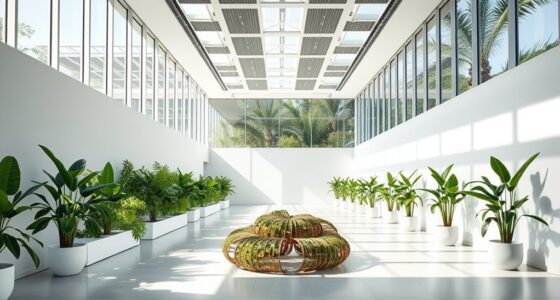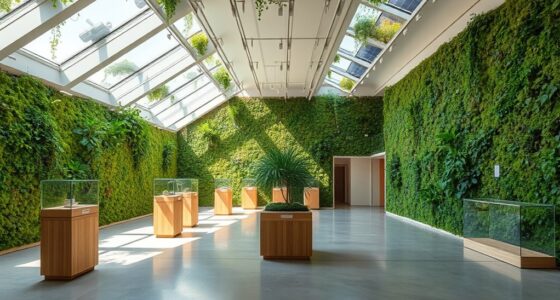Community gardens turn neglected urban spaces into artistic and vibrant hubs that showcase creativity and environmental awareness. By incorporating murals, sculptures, mosaic pathways, and repurposed materials, these gardens foster community pride and collective identity. They serve as symbols of resilience and cultural landmarks, inspiring activism and sustainability. With active participation and artistic design, you can transform a simple green space into a powerful statement of ecological responsibility and community spirit—exploring more reveals how these spaces truly come alive.
Key Takeaways
- Community gardens incorporate artistic elements like murals, sculptures, and mosaic pathways to enhance visual appeal and promote creativity.
- Collaborative art projects and planting activities foster community participation and collective identity.
- Artistic designs using recycled and repurposed materials symbolize sustainability and environmental activism.
- Gardens serve as cultural landmarks, inspiring conversations around urban renewal, sustainability, and community resilience.
- Creative green space initiatives elevate neglected areas into vibrant, eco-friendly landmarks that embody environmental innovation.

Community gardens are more than just places to grow vegetables—they serve as living canvases that transform urban spaces into vibrant works of art. When you step into these gardens, you’re not just entering a patch of cultivated land; you’re entering a dynamic environment where creativity and community come together to revitalize neighborhoods. These spaces often emerge in areas needing urban renewal, offering a fresh perspective on how cities can evolve. Instead of neglect or decay, community gardens bring new life, turning blighted lots into thriving hubs of activity and beauty. Through this process, they serve as grassroots movements for environmental activism, showing that local actions can have a broader ecological impact. By cultivating native plants, installing eco-friendly art, and encouraging sustainable practices, you become part of a movement that promotes environmental consciousness while beautifying the city. Incorporating sustainable practices into these gardens further enhances their role as eco-friendly landmarks and sources of inspiration for green innovation.
The visual impact of these gardens is undeniable. Brightly painted murals, intricate plant arrangements, and creative sculptures transform simple green spaces into open-air galleries. You might find mosaic pathways made from recycled glass, whimsical plant holders crafted from repurposed materials, or vibrant flower beds arranged in bold patterns. These artistic elements not only enhance aesthetic appeal but also communicate messages about sustainability and community pride. When you contribute your own ideas or collaborate with local artists, you help turn the garden into a reflection of collective identity. Such efforts make these spaces more inviting, encouraging residents and visitors alike to engage with their environment actively. As you participate in planting days or art projects, you’re actively shaping the narrative of urban renewal, demonstrating that community effort can produce both environmental and artistic renewal.
Furthermore, community gardens foster a sense of ownership and belonging. They become symbols of resilience, showing that neighborhoods can reclaim and reinvent neglected spaces. By incorporating art into these gardens, you elevate their significance from mere green spaces to cultural landmarks. This transformation often sparks larger conversations about urban planning, sustainability, and the power of community activism. You see, these gardens don’t just grow vegetables—they cultivate hope, creativity, and environmental responsibility. Your involvement turns the garden into a living masterpiece that embodies the spirit of urban renewal and environmental activism, inspiring others to see urban spaces as opportunities for artistic expression and ecological stewardship. Ultimately, community gardens as art remind us that, with imagination and collective effort, even the most overlooked urban corners can blossom into vibrant, meaningful landscapes.
Frequently Asked Questions
How Do Community Gardens Impact Local Biodiversity?
You notice how community gardens boost local biodiversity by providing habitats for native pollinators and encouraging diverse plant species. When you plant native flowers and maintain varied vegetation, you support pollinators like bees and butterflies, which thrive in these spaces. Your efforts increase plant diversity, creating a balanced ecosystem that benefits both wildlife and the community. This sustainable approach helps preserve the environment and enhances the garden’s natural beauty.
What Are Funding Options for Community Art Projects in Gardens?
Funding fosters fabulous, flourishing art projects in your garden. You can chase grant opportunities from local governments, arts organizations, or environmental groups that support creative community initiatives. Crowdfunding campaigns also come in handy, helping you rally residents and supporters to contribute online. Combining grants and crowdfunding creates a powerful, practical plan, providing plenty of funds to produce vibrant visual art, inspiring installations, and engaging educational exhibits within your community garden space.
How Can Art Promote Inclusivity in Community Gardening?
You can promote inclusivity in community gardening through art by encouraging public participation and showcasing cultural representation. Invite diverse community members to contribute their artistic ideas and cultural symbols, creating a space where everyone feels valued. Use murals, sculptures, or plant designs that reflect different backgrounds, fostering a sense of belonging. This approach not only beautifies the garden but also strengthens community bonds and celebrates shared diversity.
What Are Successful Examples of Art Installations in Gardens?
You’ll find successful art installations in gardens often feature sculpture integration and mural design that enhance space and engage visitors. For example, vibrant murals can reflect local culture, while sculptures add a tactile dimension. These pieces invite interaction, spark conversations, and foster community pride. When thoughtfully integrated, art installations transform gardens into inspiring, inclusive environments where everyone feels connected and inspired by the creative expression surrounding them.
How Do Community Gardens Influence Mental Health and Well-Being?
You’ll find that community gardens boost mental health benefits by reducing stress and fostering a sense of connection. Engaging with nature in these spaces enhances your emotional well-being, providing a calming escape from daily pressures. As you work alongside others, you build community and improve your mood. These gardens serve as therapeutic environments, helping you feel more grounded, energized, and resilient, ultimately supporting your overall mental health and emotional well-being.
Conclusion
As you walk through these vibrant community gardens, it’s no coincidence that they feel more like living art than mere green spaces. Every colorful flower, handcrafted sculpture, and shared smile shows how creativity and community intertwine. You realize that cultivating these gardens isn’t just about growing plants, but about nurturing connections and inspiring beauty in unexpected places. Sometimes, the most extraordinary art blooms quietly, right where you least expect it—just like in your own neighborhood.








